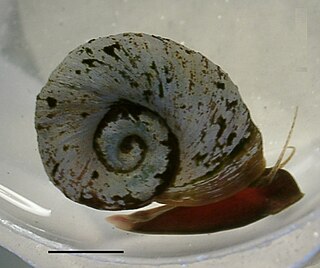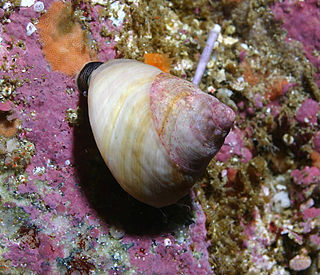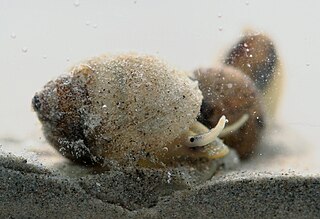
Hydrobiidae, commonly known as mud snails, is a large cosmopolitan family of very small freshwater and brackish water snails with an operculum; they are in the order Littorinimorpha.

Planorbidae, common name the ramshorn snails or ram's horn snails, is a family of air-breathing freshwater snails, aquatic pulmonate gastropod molluscs. Unlike most molluscs, the blood of ram's horn snails contains iron-based hemoglobin instead of copper-based hemocyanin. As a result, planorbids are able to breathe oxygen more efficiently than other molluscs. The presence of hemoglobin gives the body a reddish colour. This is especially apparent in albino animals.

Viviparidae, sometimes known as the river snails or mystery snails, are a family of large aquatic gastropod mollusks, being some of the most widely distributed operculate freshwater snails.

Vertigo is a genus of minute, air-breathing land snails, terrestrial pulmonate gastropod molluscs or micromollusks in the family Vertiginidae, the whorl snails.

Onchidiidae are a family of small, air-breathing sea slugs. They are shell-less marine pulmonate gastropod molluscs. Onchidiidae is the only family within the superfamily Onchidioidea.

Neritidae, common name the nerites, is a taxonomic family of small to medium-sized saltwater and freshwater snails which have a gill and a distinctive operculum. The family Neritidae includes marine genera such as Nerita, marine and freshwater genera such as Neritina, and freshwater and brackish water genera such as Theodoxus.

Acroloxidae, commonly known as river limpets, are a taxonomic family of very small, freshwater snails, aquatic pulmonate gastropod limpet-like mollusks with a simple flattened conical shell in the clade Hygrophila.

Melanoides is a genus of freshwater snail with an operculum, an aquatic gastropod mollusk in the subfamily Thiarinae of the family Thiaridae.

Theodoxus is a genus of nerites, small water snails with an operculum, some of which live in freshwater, and some in both freshwater and brackish water, aquatic gastropod mollusks in the family Neritidae, the nerites.

Thiaridae, common name thiarids or trumpet snails, is a family of tropical freshwater snails with an operculum, aquatic gastropod mollusks in the superfamily Cerithioidea.

Trochoidea is a superfamily of small to very large vetigastropod sea snails with gills and an operculum. Species within this superfamily have nacre as the inner shell layer. The families within this superfamily include the Trochidae, the top snails. This superfamily is the largest vetigastropodan superfamily, containing more than 2,000 species.

Amnicolidae is a family of small freshwater snails with a gill and an operculum, aquatic gastropod mollusks in the superfamily Rissooidea.

Lithoglyphidae is a family of small freshwater snails with gills and an operculum, aquatic gastropod mollusks.

Fossarina is a genus of sea snails, marine gastropod molluscs in the family Trochidae, the top shells.

Pachychilidae, common name pachychilids, is a taxonomic family of freshwater snails, gastropod molluscs in the clade Sorbeoconcha.

Cleopatra is a genus of freshwater snails with an operculum, aquatic gastropod molluscs in the family Paludomidae within the subfamily Cleopatrinae.

Bellamya is a genus of freshwater snails with a gill and an operculum, aquatic gastropod mollusks in the family Viviparidae.

Teratobaikalia macrostoma is a species of a freshwater snail with an operculum, an aquatic gastropod mollusk in the family Amnicolidae.

Unioninae is a subfamily of freshwater mussels in the family Unionidae. This superfamily has a wide distribution, being found throughout Eurasia, North America and Africa.

















